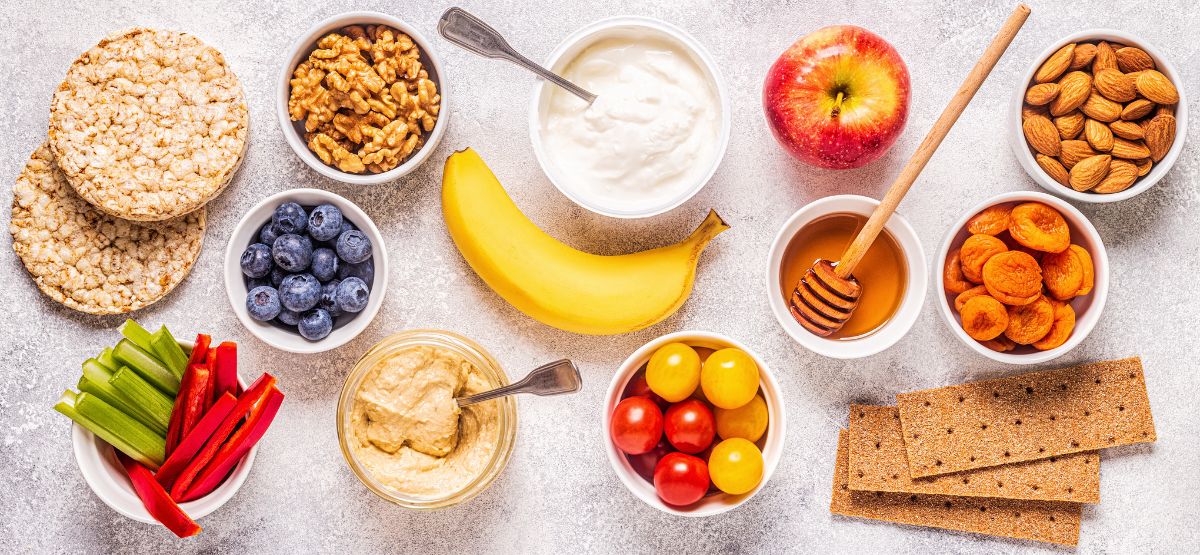Whether you are meeting your kids at the neighborhood bus stop on the corner, or greeting them expectantly as they enter through the front door, it won’t take long before you hear those familiar words, “I’m so hungry! What do we have to eat?”
Learning is hard work, moms and dads, and all the obligations and excitement of the day can leave your students feeling famished by the time they finally get home. The early wakeup, chaotic school bus ride, anxiety-producing tests and quizzes, athletic competitions, club tryouts, and often challenging social interactions can leave even the perkiest student feeling spent and droopy. But have no fear…
Cue the after-school snack!
A well-timed afternoon snack can be a wonderful source of energy, of course, but it’s also a powerful form of comfort and reassurance after a demanding, and maybe difficult, day. With this in mind, how can we best nourish our children’s fatigued bodies and overwhelmed brains so that they have a chance to decompress and enjoy some downtime at home as the evening hours approach? What kinds of foods will best replenish their energy stores, and gently ease their bodies and emotions back into a state of balance and calm?
First off, an after-school snack should center around real whole foods. All the packaged goodies can be cheap, easy, and tempting, but they do not provide the nutrient-dense sources of carbohydrates, fat, and protein that growing bodies demand. Reaching for these products will actually result in more severe stress response and even compromised immunity and resilience over time, even if they seem to bring immediate contentment in the moment. Avoid this trap and play the long game!
Second, to restore proper blood sugar balance, it is wise to avoid straight carbohydrate snacks such as pretzels, a fruit drink, or even a banana. Remember the mantra, NO NAKED CARBS, meaning you want to offer your child a carbohydrate with fat and/or protein so that you don’t send their blood sugar skyrocketing. Fat and protein require more time to digest, so bellies stay fuller for longer and the body isn’t forced to respond to a sudden influx of sugar – even the natural kind. Dysregulated blood sugar is an extremely stressful event for the body, and the resulting symptoms can look very much like problematic behavioral outbursts – crankiness, low mood, fatigue, irritability, even aggressiveness. This is the body communicating to whomever will listen that things are significantly out of balance, and left unheeded – these warning signals can lead to diabetes, obesity, and other related health complications. We can sidestep and often completely avoid these events with consistently wise food choices – namely, stick to unprocessed foods and pair your fiber-rich carbs with natural fat and protein.
The third guideline to keep in mind is determining true hunger versus cravings. I will sometimes ask my kids, “Are you hungry, or do you just want a little something?” If they are legitimately hungry, I will go heavier on the protein and fat to be sure they are satiated until it is time for dinner. If they just want a quick bite for energy (or even just for fun or for a distraction, which is okay when used judiciously), I still select from whole food options, but will not be as strict with macronutrient ratios. For example, I’ll hand over an entire apple and not worry about adding nuts.
 |
Below are some real food ideas to put these guidelines into action. Notice how carbohydrates are always paired with fat and/or protein. You of course have the freedom to use alternative fruit and vegetables to accommodate your child’s preferences. These are just some options to get you started:
1. Banana with nut butter (substitute sunbutter in case of nut allergy)
2. Apple slices with an organic cheese stick
3. Cucumber coins with fresh guacamole
4. Salami and cheese with olives
5. Applegate Farms breakfast sausages and unsweetened applesauce pouch
6. Full-fat plain yogurt mixed with honey and fresh fruit
7. Assorted nuts (dry roasted or raw – avoid any products with added oils) and pickle wedges
8. Carrot sticks and hummus
9. proteinDeli ham/turkey and cheese rollup with grapes
10. Fruit smoothie made with good fat and protein (organic and full fat milk of choice, nut butter, avocado chunks, quality protein powder such as this.
Full disclosure: I understand this transition to healthier snacks might take some patience and persistence. Obviously, the options listed here will struggle to compete with a bag of Doritos and a brightly colored blue raspberry beverage, and your child will likely resist the good food, wear you down, and hold out for the processed stuff if they know those items are still within reach.
Being aware of this reality, I strongly recommend that you simply make the less optimal choices unavailable in your home. You can do this slowly if you feel that might cause less drama, or you can rip off the proverbial band-aid quickly and purge all the junky snacks at once. We can’t eat what we don’t buy! If your child is truly hungry, he or she will begin to welcome the healthier options, and in time, will even grow to love them. The best news of all - with snack selections like these offered consistently, you will see your child’s mood, energy, performance, and ability to focus level out and optimize. And what parent wouldn’t love to witness that?
Amy is a mom and nutritionist with the following distinctions: Primal Health Coach (PHC), Functional Nutritional Therapy Practitioner (FNTP), Functional Blood Chemistry Specialist (FBCS), and Functional Hormone Specialist (FHS).



